Business Decision Making: NPV, Payback, and Financial Factors
VerifiedAdded on 2023/01/11
|7
|1358
|69
Essay
AI Summary
This essay examines business decision-making through the lens of capital budgeting techniques, specifically net present value (NPV) and payback period. It uses a case study of XYZ Plc, a budget chain restaurant considering investments in software or a laundrette project. The essay calculates and compares the NPV and payback periods for both projects, demonstrating how these techniques help in evaluating investment opportunities. It also discusses financial and non-financial factors influencing the decision, such as UK financial security and potential legislation. The conclusion recommends project B (laundrette) for better growth and success, based on the analysis. The essay emphasizes the importance of these techniques in making informed business decisions.

Business decision making
Paraphrase This Document
Need a fresh take? Get an instant paraphrase of this document with our AI Paraphraser

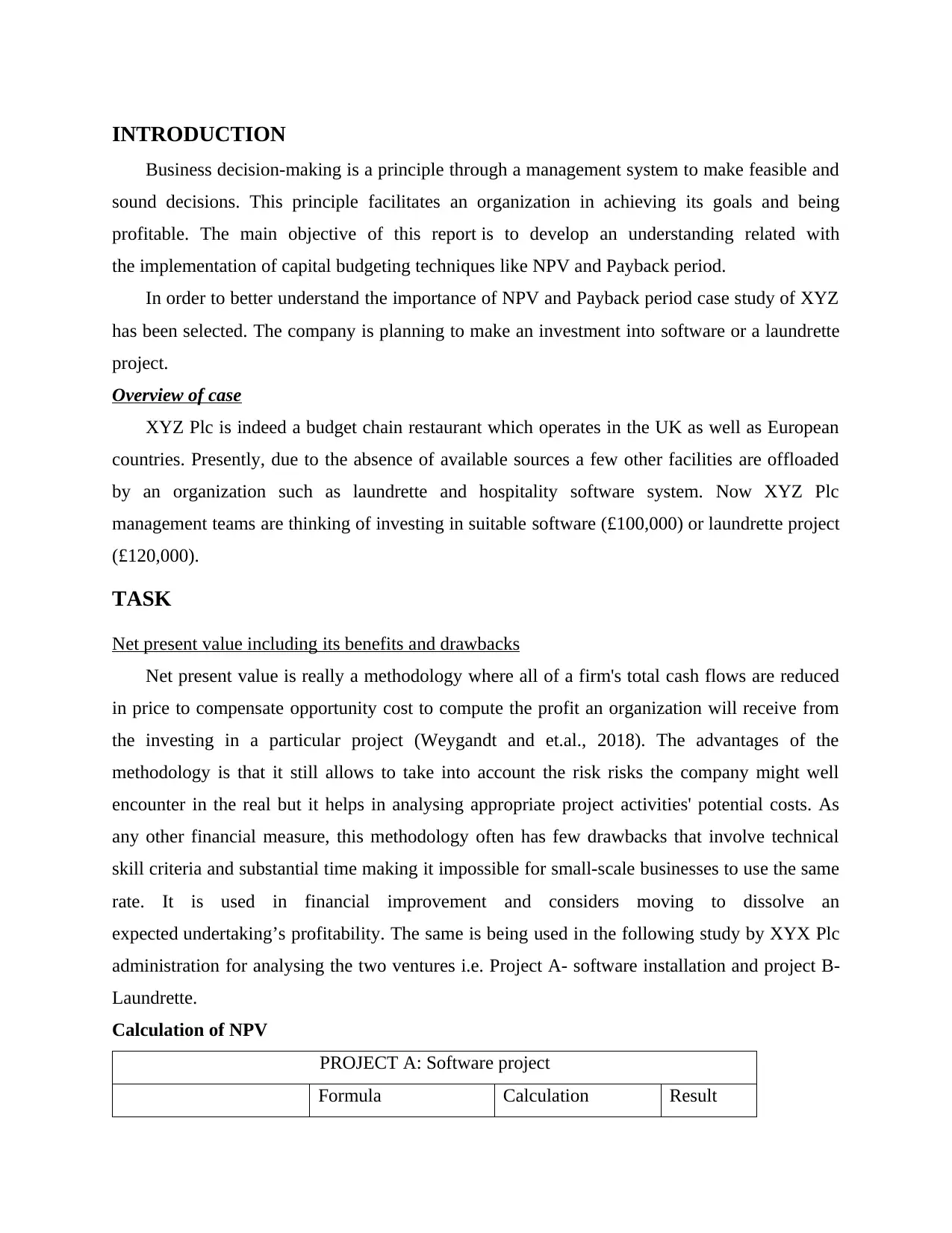
INTRODUCTION
Business decision-making is a principle through a management system to make feasible and
sound decisions. This principle facilitates an organization in achieving its goals and being
profitable. The main objective of this report is to develop an understanding related with
the implementation of capital budgeting techniques like NPV and Payback period.
In order to better understand the importance of NPV and Payback period case study of XYZ
has been selected. The company is planning to make an investment into software or a laundrette
project.
Overview of case
XYZ Plc is indeed a budget chain restaurant which operates in the UK as well as European
countries. Presently, due to the absence of available sources a few other facilities are offloaded
by an organization such as laundrette and hospitality software system. Now XYZ Plc
management teams are thinking of investing in suitable software (£100,000) or laundrette project
(£120,000).
TASK
Net present value including its benefits and drawbacks
Net present value is really a methodology where all of a firm's total cash flows are reduced
in price to compensate opportunity cost to compute the profit an organization will receive from
the investing in a particular project (Weygandt and et.al., 2018). The advantages of the
methodology is that it still allows to take into account the risk risks the company might well
encounter in the real but it helps in analysing appropriate project activities' potential costs. As
any other financial measure, this methodology often has few drawbacks that involve technical
skill criteria and substantial time making it impossible for small-scale businesses to use the same
rate. It is used in financial improvement and considers moving to dissolve an
expected undertaking’s profitability. The same is being used in the following study by XYX Plc
administration for analysing the two ventures i.e. Project A- software installation and project B-
Laundrette.
Calculation of NPV
PROJECT A: Software project
Formula Calculation Result
Business decision-making is a principle through a management system to make feasible and
sound decisions. This principle facilitates an organization in achieving its goals and being
profitable. The main objective of this report is to develop an understanding related with
the implementation of capital budgeting techniques like NPV and Payback period.
In order to better understand the importance of NPV and Payback period case study of XYZ
has been selected. The company is planning to make an investment into software or a laundrette
project.
Overview of case
XYZ Plc is indeed a budget chain restaurant which operates in the UK as well as European
countries. Presently, due to the absence of available sources a few other facilities are offloaded
by an organization such as laundrette and hospitality software system. Now XYZ Plc
management teams are thinking of investing in suitable software (£100,000) or laundrette project
(£120,000).
TASK
Net present value including its benefits and drawbacks
Net present value is really a methodology where all of a firm's total cash flows are reduced
in price to compensate opportunity cost to compute the profit an organization will receive from
the investing in a particular project (Weygandt and et.al., 2018). The advantages of the
methodology is that it still allows to take into account the risk risks the company might well
encounter in the real but it helps in analysing appropriate project activities' potential costs. As
any other financial measure, this methodology often has few drawbacks that involve technical
skill criteria and substantial time making it impossible for small-scale businesses to use the same
rate. It is used in financial improvement and considers moving to dissolve an
expected undertaking’s profitability. The same is being used in the following study by XYX Plc
administration for analysing the two ventures i.e. Project A- software installation and project B-
Laundrette.
Calculation of NPV
PROJECT A: Software project
Formula Calculation Result
⊘ This is a preview!⊘
Do you want full access?
Subscribe today to unlock all pages.

Trusted by 1+ million students worldwide
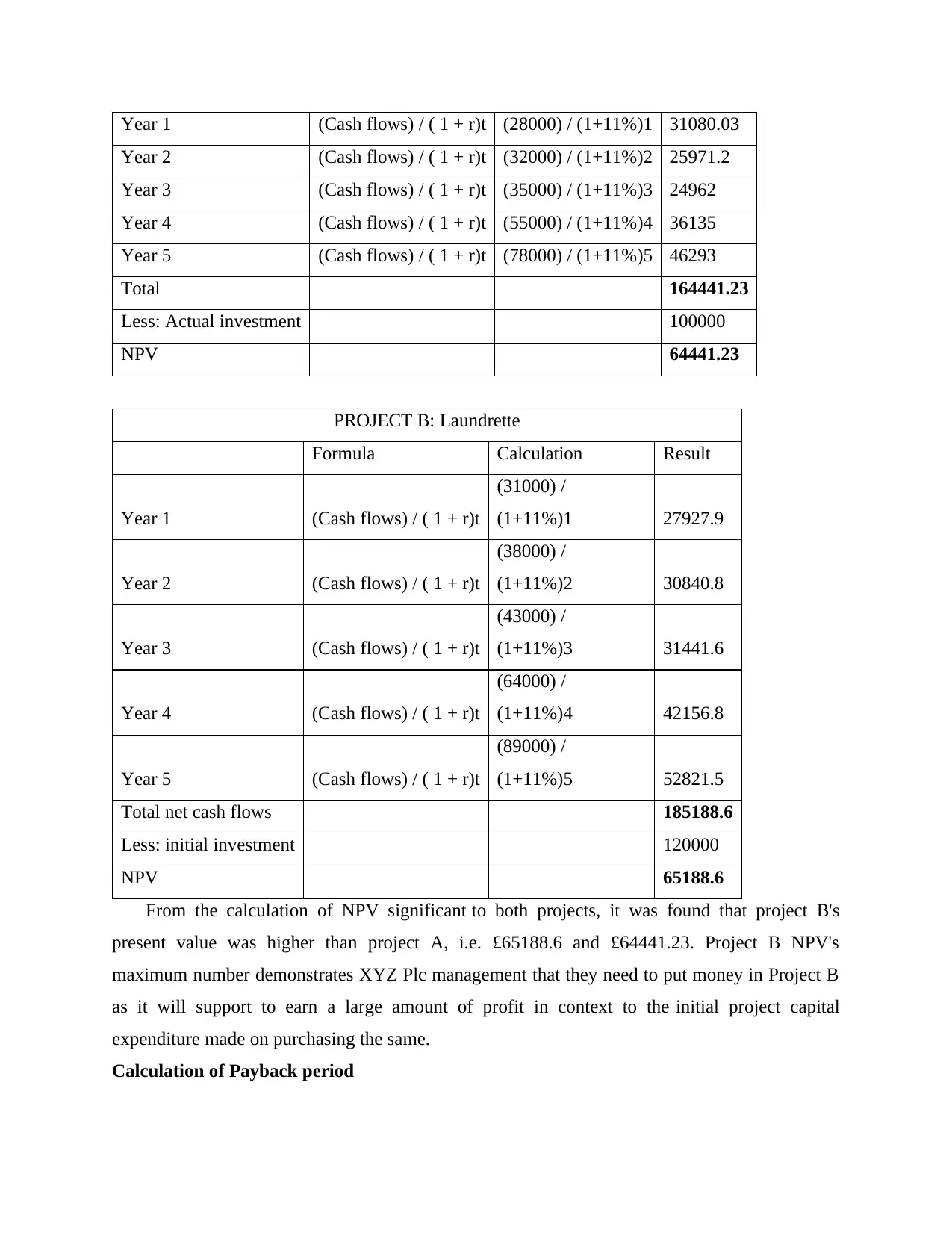
Year 1 (Cash flows) / ( 1 + r)t (28000) / (1+11%)1 31080.03
Year 2 (Cash flows) / ( 1 + r)t (32000) / (1+11%)2 25971.2
Year 3 (Cash flows) / ( 1 + r)t (35000) / (1+11%)3 24962
Year 4 (Cash flows) / ( 1 + r)t (55000) / (1+11%)4 36135
Year 5 (Cash flows) / ( 1 + r)t (78000) / (1+11%)5 46293
Total 164441.23
Less: Actual investment 100000
NPV 64441.23
PROJECT B: Laundrette
Formula Calculation Result
Year 1 (Cash flows) / ( 1 + r)t
(31000) /
(1+11%)1 27927.9
Year 2 (Cash flows) / ( 1 + r)t
(38000) /
(1+11%)2 30840.8
Year 3 (Cash flows) / ( 1 + r)t
(43000) /
(1+11%)3 31441.6
Year 4 (Cash flows) / ( 1 + r)t
(64000) /
(1+11%)4 42156.8
Year 5 (Cash flows) / ( 1 + r)t
(89000) /
(1+11%)5 52821.5
Total net cash flows 185188.6
Less: initial investment 120000
NPV 65188.6
From the calculation of NPV significant to both projects, it was found that project B's
present value was higher than project A, i.e. £65188.6 and £64441.23. Project B NPV's
maximum number demonstrates XYZ Plc management that they need to put money in Project B
as it will support to earn a large amount of profit in context to the initial project capital
expenditure made on purchasing the same.
Calculation of Payback period
Year 2 (Cash flows) / ( 1 + r)t (32000) / (1+11%)2 25971.2
Year 3 (Cash flows) / ( 1 + r)t (35000) / (1+11%)3 24962
Year 4 (Cash flows) / ( 1 + r)t (55000) / (1+11%)4 36135
Year 5 (Cash flows) / ( 1 + r)t (78000) / (1+11%)5 46293
Total 164441.23
Less: Actual investment 100000
NPV 64441.23
PROJECT B: Laundrette
Formula Calculation Result
Year 1 (Cash flows) / ( 1 + r)t
(31000) /
(1+11%)1 27927.9
Year 2 (Cash flows) / ( 1 + r)t
(38000) /
(1+11%)2 30840.8
Year 3 (Cash flows) / ( 1 + r)t
(43000) /
(1+11%)3 31441.6
Year 4 (Cash flows) / ( 1 + r)t
(64000) /
(1+11%)4 42156.8
Year 5 (Cash flows) / ( 1 + r)t
(89000) /
(1+11%)5 52821.5
Total net cash flows 185188.6
Less: initial investment 120000
NPV 65188.6
From the calculation of NPV significant to both projects, it was found that project B's
present value was higher than project A, i.e. £65188.6 and £64441.23. Project B NPV's
maximum number demonstrates XYZ Plc management that they need to put money in Project B
as it will support to earn a large amount of profit in context to the initial project capital
expenditure made on purchasing the same.
Calculation of Payback period
Paraphrase This Document
Need a fresh take? Get an instant paraphrase of this document with our AI Paraphraser
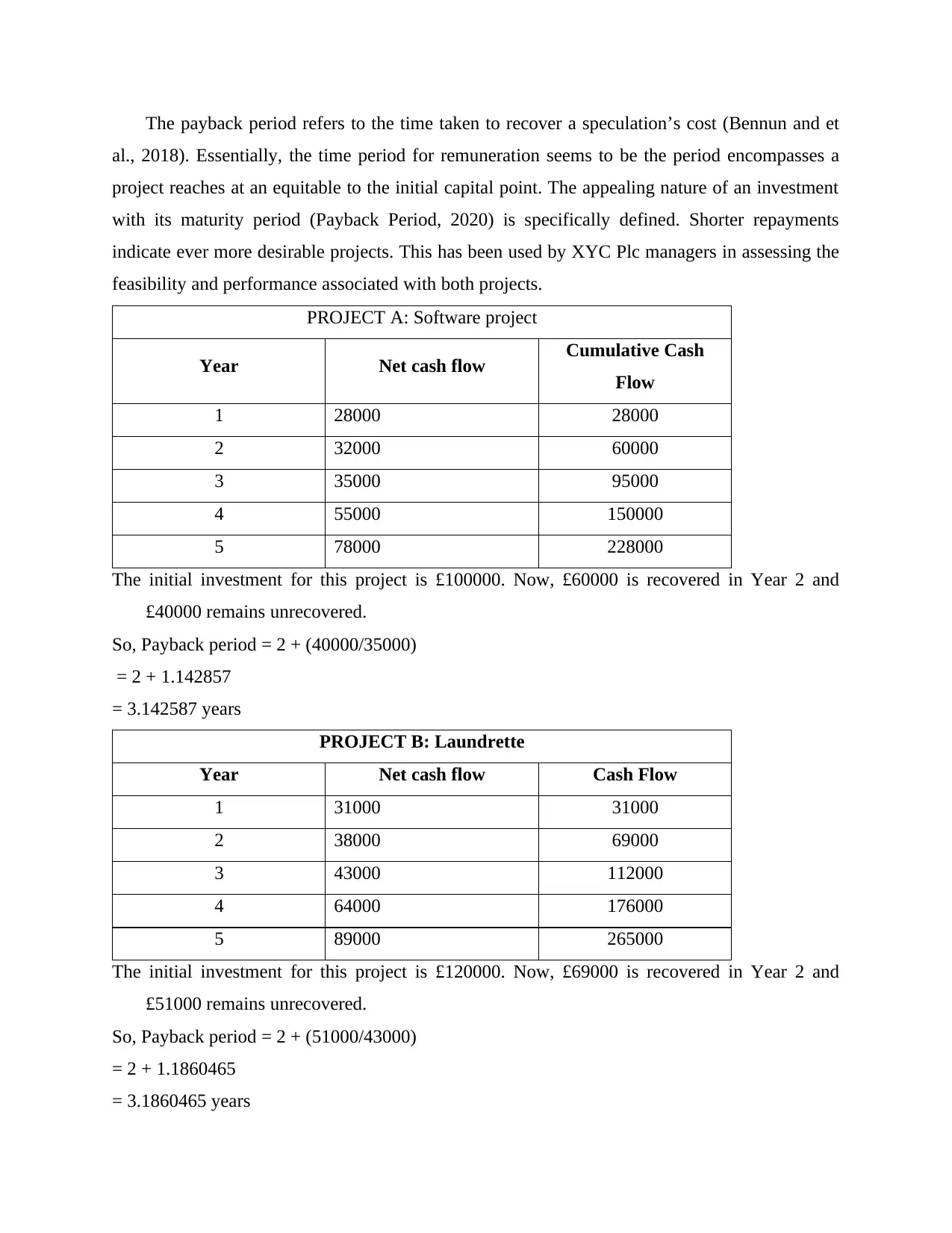
The payback period refers to the time taken to recover a speculation’s cost (Bennun and et
al., 2018). Essentially, the time period for remuneration seems to be the period encompasses a
project reaches at an equitable to the initial capital point. The appealing nature of an investment
with its maturity period (Payback Period, 2020) is specifically defined. Shorter repayments
indicate ever more desirable projects. This has been used by XYC Plc managers in assessing the
feasibility and performance associated with both projects.
PROJECT A: Software project
Year Net cash flow Cumulative Cash
Flow
1 28000 28000
2 32000 60000
3 35000 95000
4 55000 150000
5 78000 228000
The initial investment for this project is £100000. Now, £60000 is recovered in Year 2 and
£40000 remains unrecovered.
So, Payback period = 2 + (40000/35000)
= 2 + 1.142857
= 3.142587 years
PROJECT B: Laundrette
Year Net cash flow Cash Flow
1 31000 31000
2 38000 69000
3 43000 112000
4 64000 176000
5 89000 265000
The initial investment for this project is £120000. Now, £69000 is recovered in Year 2 and
£51000 remains unrecovered.
So, Payback period = 2 + (51000/43000)
= 2 + 1.1860465
= 3.1860465 years
al., 2018). Essentially, the time period for remuneration seems to be the period encompasses a
project reaches at an equitable to the initial capital point. The appealing nature of an investment
with its maturity period (Payback Period, 2020) is specifically defined. Shorter repayments
indicate ever more desirable projects. This has been used by XYC Plc managers in assessing the
feasibility and performance associated with both projects.
PROJECT A: Software project
Year Net cash flow Cumulative Cash
Flow
1 28000 28000
2 32000 60000
3 35000 95000
4 55000 150000
5 78000 228000
The initial investment for this project is £100000. Now, £60000 is recovered in Year 2 and
£40000 remains unrecovered.
So, Payback period = 2 + (40000/35000)
= 2 + 1.142857
= 3.142587 years
PROJECT B: Laundrette
Year Net cash flow Cash Flow
1 31000 31000
2 38000 69000
3 43000 112000
4 64000 176000
5 89000 265000
The initial investment for this project is £120000. Now, £69000 is recovered in Year 2 and
£51000 remains unrecovered.
So, Payback period = 2 + (51000/43000)
= 2 + 1.1860465
= 3.1860465 years
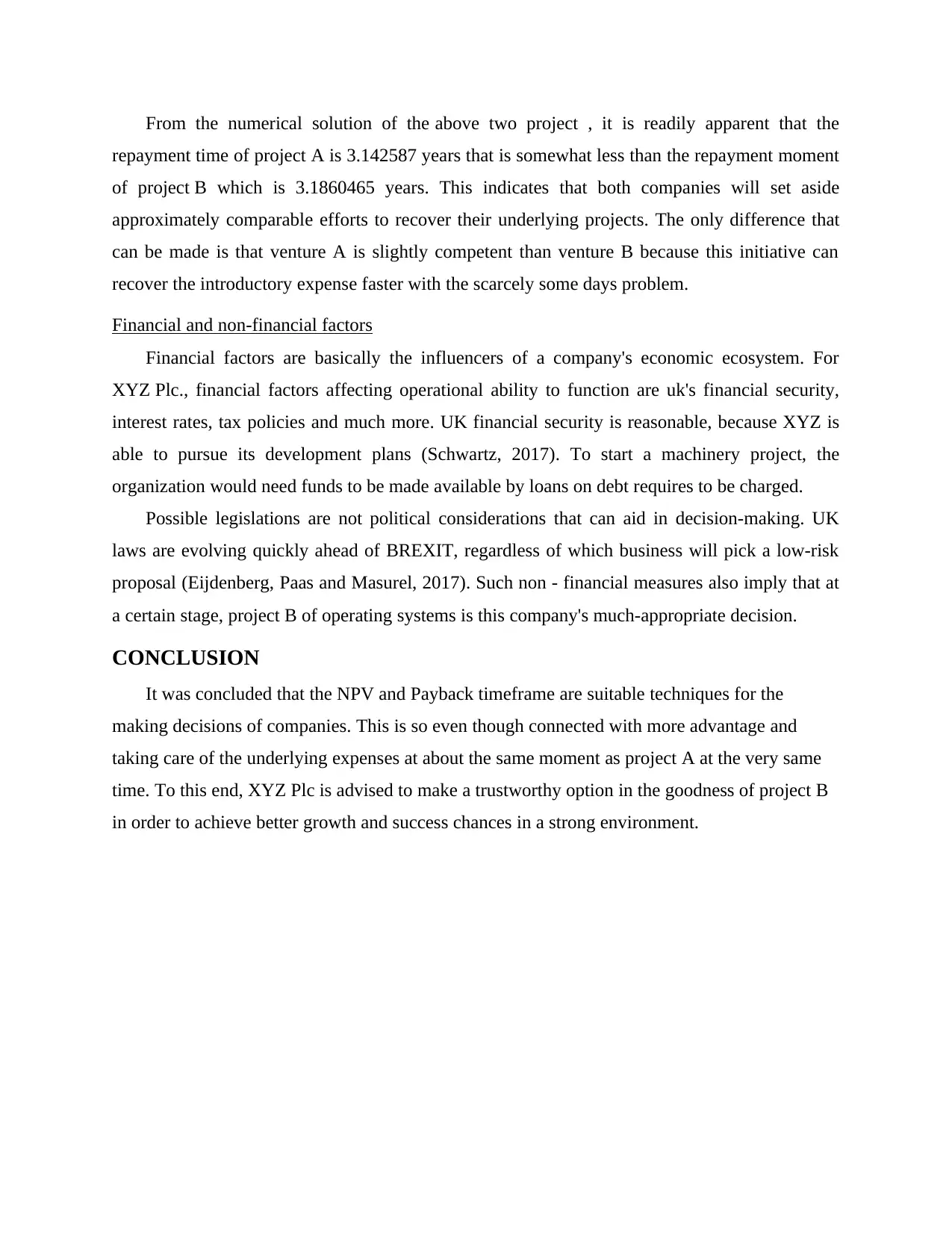
From the numerical solution of the above two project , it is readily apparent that the
repayment time of project A is 3.142587 years that is somewhat less than the repayment moment
of project B which is 3.1860465 years. This indicates that both companies will set aside
approximately comparable efforts to recover their underlying projects. The only difference that
can be made is that venture A is slightly competent than venture B because this initiative can
recover the introductory expense faster with the scarcely some days problem.
Financial and non-financial factors
Financial factors are basically the influencers of a company's economic ecosystem. For
XYZ Plc., financial factors affecting operational ability to function are uk's financial security,
interest rates, tax policies and much more. UK financial security is reasonable, because XYZ is
able to pursue its development plans (Schwartz, 2017). To start a machinery project, the
organization would need funds to be made available by loans on debt requires to be charged.
Possible legislations are not political considerations that can aid in decision-making. UK
laws are evolving quickly ahead of BREXIT, regardless of which business will pick a low-risk
proposal (Eijdenberg, Paas and Masurel, 2017). Such non - financial measures also imply that at
a certain stage, project B of operating systems is this company's much-appropriate decision.
CONCLUSION
It was concluded that the NPV and Payback timeframe are suitable techniques for the
making decisions of companies. This is so even though connected with more advantage and
taking care of the underlying expenses at about the same moment as project A at the very same
time. To this end, XYZ Plc is advised to make a trustworthy option in the goodness of project B
in order to achieve better growth and success chances in a strong environment.
repayment time of project A is 3.142587 years that is somewhat less than the repayment moment
of project B which is 3.1860465 years. This indicates that both companies will set aside
approximately comparable efforts to recover their underlying projects. The only difference that
can be made is that venture A is slightly competent than venture B because this initiative can
recover the introductory expense faster with the scarcely some days problem.
Financial and non-financial factors
Financial factors are basically the influencers of a company's economic ecosystem. For
XYZ Plc., financial factors affecting operational ability to function are uk's financial security,
interest rates, tax policies and much more. UK financial security is reasonable, because XYZ is
able to pursue its development plans (Schwartz, 2017). To start a machinery project, the
organization would need funds to be made available by loans on debt requires to be charged.
Possible legislations are not political considerations that can aid in decision-making. UK
laws are evolving quickly ahead of BREXIT, regardless of which business will pick a low-risk
proposal (Eijdenberg, Paas and Masurel, 2017). Such non - financial measures also imply that at
a certain stage, project B of operating systems is this company's much-appropriate decision.
CONCLUSION
It was concluded that the NPV and Payback timeframe are suitable techniques for the
making decisions of companies. This is so even though connected with more advantage and
taking care of the underlying expenses at about the same moment as project A at the very same
time. To this end, XYZ Plc is advised to make a trustworthy option in the goodness of project B
in order to achieve better growth and success chances in a strong environment.
⊘ This is a preview!⊘
Do you want full access?
Subscribe today to unlock all pages.

Trusted by 1+ million students worldwide
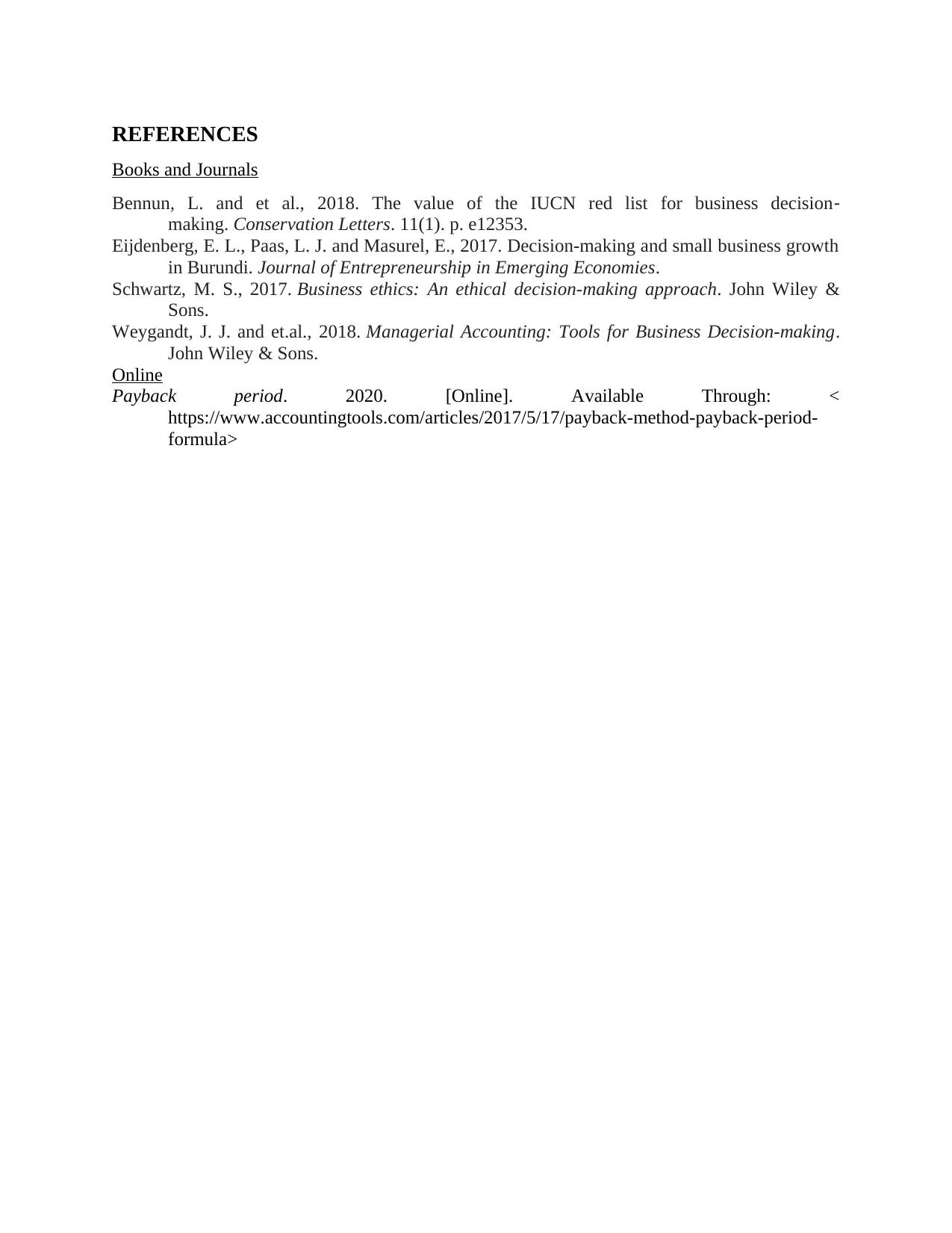
REFERENCES
Books and Journals
Bennun, L. and et al., 2018. The value of the IUCN red list for business decision‐
making. Conservation Letters. 11(1). p. e12353.
Eijdenberg, E. L., Paas, L. J. and Masurel, E., 2017. Decision-making and small business growth
in Burundi. Journal of Entrepreneurship in Emerging Economies.
Schwartz, M. S., 2017. Business ethics: An ethical decision-making approach. John Wiley &
Sons.
Weygandt, J. J. and et.al., 2018. Managerial Accounting: Tools for Business Decision-making.
John Wiley & Sons.
Online
Payback period. 2020. [Online]. Available Through: <
https://www.accountingtools.com/articles/2017/5/17/payback-method-payback-period-
formula>
Books and Journals
Bennun, L. and et al., 2018. The value of the IUCN red list for business decision‐
making. Conservation Letters. 11(1). p. e12353.
Eijdenberg, E. L., Paas, L. J. and Masurel, E., 2017. Decision-making and small business growth
in Burundi. Journal of Entrepreneurship in Emerging Economies.
Schwartz, M. S., 2017. Business ethics: An ethical decision-making approach. John Wiley &
Sons.
Weygandt, J. J. and et.al., 2018. Managerial Accounting: Tools for Business Decision-making.
John Wiley & Sons.
Online
Payback period. 2020. [Online]. Available Through: <
https://www.accountingtools.com/articles/2017/5/17/payback-method-payback-period-
formula>
1 out of 7
Related Documents
Your All-in-One AI-Powered Toolkit for Academic Success.
+13062052269
info@desklib.com
Available 24*7 on WhatsApp / Email
![[object Object]](/_next/static/media/star-bottom.7253800d.svg)
Unlock your academic potential
Copyright © 2020–2025 A2Z Services. All Rights Reserved. Developed and managed by ZUCOL.





